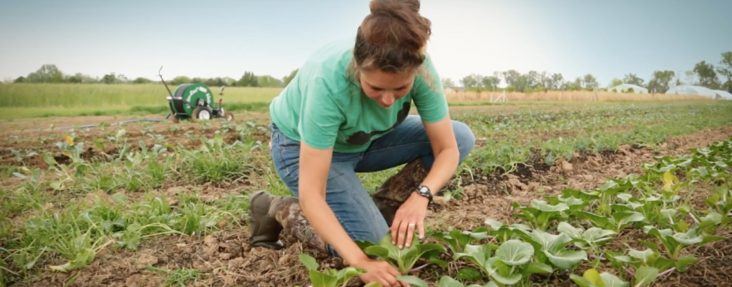Heifer International hopes to help small-scale farmers in Arkansas thrive
by July 13, 2017 6:44 pm 2,101 views

Powdered milk in Spain more than 70-years ago may change the modern farming culture in Arkansas. Dan West, an American farmer who volunteered to help fight hunger during the Spanish Civil War in the late 1930s, quickly discovered the single cup of powdered milk given to war refugees each day was not enough to sustain them.
“Why a cup and not a whole cow?” he mused to himself.
West would later found Heifer International, an organization working to fight food shortages around the world. About five years ago the Arkansas-based organization decided to expand its operations through the development of its domestic division (Heifer USA) aimed at aiding small-scale farmers, Heifer USA Director of Operations Ben Wihebrink told Talk Business & Politics. Two agriculture cooperatives, Grass Roots and New South Produce, have received Heifer backing in Arkansas. The goal is to develop a cooperative model that allows small-scale farmers the opportunity to make a living doing what they love – farming.
“A small-scale farmer can make a livable wage … families don’t have to migrate out of rural areas as manufacturing and other jobs vanish,” he said.
Heifer has dedicated more than $3 million towards Grassroots, which focuses on livestock farming, and just under $1 million towards New South which focuses on crop production. Startup costs for livestock farming are higher, he said. Farmers involved in crop production typically just have to be re-trained to meet Heifer guidelines, which is less expensive, he said.
The cooperative programs in Arkansas are essentially pilot programs the organization hopes to develop with the goal of taking them nationwide, Wihebrink said. The problem for most smaller farmers is that their operations are small, and they make little money. The United States Department of Agriculture estimates that farmers make about 16-cents on every dollar spent on food. Commercial agriculture producers can survive with those margins because of volume; mom and pops farmers usually can’t. Heifer’s goal to push farmers into the 75-80 cent on every dollar range, he said.
Cooperatives are composed of local farmers, and the farmers decide their own board members. The cooperatives find particular markets for agriculture products. Packaging and transportation logistics are also vetted. By removing these obstacles, the farmers in the program can focus more time on developing better products and ultimately that will lead to a higher income, he said.
“A small-scale farmer should be able to make $45,000 per year,” he said. “We believe that’s attainable.”
A cooperative can buy input products such as fertilizer, seed, or feed at bulk rates, meaning the members will pay less for those items, he said. Lines of credit and other financial tools are also made available to members.
In return, members have to adhere to Heifer’s farm quality policies. Many of the farming techniques are developed at the Heifer Ranch in Perryville. The techniques are environmentally safe, and produce higher quality, healthier food, he said. For example, chickens are primarily raised on pasture lands, not in chicken coops. They eat pasture grasses and clover as opposed to processed feed.
Arkansas was the perfect place to develop these programs, Wilebrink said. Heifer is already located here, and the state’s agriculture and subsequent marketing in that sector is “infantile” in its development and diversity. States on the west and east coasts have defined food preferences which means producers in those states know what to grow and how to grow it for markets in those places. Arkansas is still in the developmental stage, he said. The state is small, and attempts to change the culture in a larger state when the model hasn’t been proven would be much harder, he said.
There have been problems with the cooperative model. It’s a challenge to get farmers from diverse backgrounds to work and trust each other. Development of relationships between farmers from the Delta, Ozarks, and the River Valley can be a challenge. Some are Republicans, others are Democrats, or no party at all. They come from varied ethnic backgrounds, he said. There is also some age disparity, but most of their farmers tend to be younger than the average, he said. Once they do form those bonds and trust the process, the model works well, he said.
Another problem is a lack of meat processing facilities in the state. In the coming years officials hope to identify needed infrastructure improvements, and find other capital sources for cooperative members. The goal with the cooperatives is to have them self-sustainable by 2019-20. After, that, the hope is the models can be used to aid small-scale farmers in other states.
New farming techniques are being developed at the Heifer Ranch. USDA trial testing may be done at the Ranch, too. Each year about 25,000 students visit the Ranch to learn about sustainable farm practices. Heifer has its Urban Village and farm in Little Rock, and it the Heifer Farm in Massachusetts.
Revolutionizing small-scale farming is no small undertaking, he said. Heifer has helped directly impacted at least 30 farmers in Arkansas during the last year, and has aided up to 400 statewide since last year. The organization ultimately hopes to bring 4 million from the doldrums of food poverty by 2020. Saving farms in rural America is also on that project list, he said.
“Providing healthy, delicious food is a byproduct of what we’re trying to accomplish,” he said.
–––––––––––––––––––
Editor’s note: This is the first of two stories about Heifer International.
